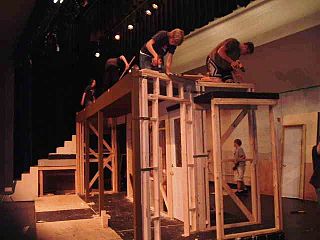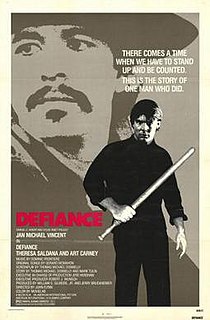Related Research Articles

A film crew is a group of people, hired by a production company, for the purpose of producing a film or motion picture. The crew is distinguished from the cast as the cast are understood to be the actors who appear in front of the camera or provide voices for characters in the film. The crew is also separate from the producers as the producers are the ones who own a portion of either the film company or the film's intellectual property rights. A film crew is divided into different departments, each of which specializes in a specific aspect of the production. Film crew positions have evolved over the years, spurred by technological change, but many traditional jobs date from the early 20th century and are common across jurisdictions and film-making cultures.
Mise-en-scène is an expression used to describe the design aspect of a theatre or film production, which essentially means "visual theme" or "telling a story"—both in visually artful ways through storyboarding, cinematography and stage design, and in poetically artful ways through direction. It is also commonly used to refer to single scenes within the film to represent the film. Mise-en-scène has been called film criticism's "grand undefined term".

Set construction is the process undertaken by a construction manager to build full-scale scenery, as specified by a production designer or art director working in collaboration with the director of a production to create a set for a theatrical, film or television production. The set designer produces a scale model, scale drawings, paint elevations, and research about props, textures, and so on. Scale drawings typically include a groundplan, elevation, and section of the complete set, as well as more detailed drawings of individual scenic elements which, in theatrical productions, may be static, flown, or built onto scenery wagons. Models and paint elevations are frequently hand-produced, though in recent years, many Production Designers and most commercial theatres have begun producing scale drawings with the aid of computer drafting programs such as AutoCAD or Vectorworks.
Pre-production is the process of planning some of the elements involved in a film, play, or other performance. There are three parts in a production: pre-production, production, and post-production. Pre-production ends when the planning ends and the content starts being produced.
Art department in filmmaking terms means the section of a production's crew concerned with visual artistry. Working under the supervision of the production designer and/or art director, the art department is responsible for arranging the overall look of the film as desired by the film director. Individual positions within this department include: production designer, art director, assistant art director, storyboard artist, concept artist, draftsman, art department coordinator, set decorator, set dresser, makeup artist, painter, property master, leadman, swing gang, production buyer, Film sculptor, and property assistant.

A prop, formally known as (theatrical) property, is an object used on stage or screen by actors during a performance or screen production. In practical terms, a prop is considered to be anything movable or portable on a stage or a set, distinct from the actors, scenery, costumes, and electrical equipment. Consumable food items appearing in the production are also considered props.

Warner Bros. Studios, Leavesden is an 80 ha studio complex in Leavesden in Hertfordshire, in southeast England. Formerly known as Leavesden Film Studios and still colloquially known as Leavesden Studios or simply Leavesden, it is a film and media complex owned by Warner Bros. The studios were all converted from an aircraft factory and airfield called Leavesden Aerodrome, a centre of British aircraft production during World War II. It is situated in Abbots Langley, near Watford, in southwest Hertfordshire.
Principal photography is the phase of film production in which the bulk of the movie is filmed, with actors on set and cameras rolling, as distinct from pre-production and post-production. Principal photography is typically the most expensive phase of film production, due to actor, director, and set crew salaries, as well as the costs of certain shots, props, and on-set special effects.
Staging is the process of selecting, designing, adapting to, or modifying the performance space for a play or film. This includes the use or absence of stagecraft elements as well as the structure of the stage and its components.
The property master, often called the prop(s) master, is an artistic and organizational employee in a film, television or theatrical production who is responsible for purchasing, acquiring, manufacturing, properly placing, and/or overseeing any props needed for a production. The property master also works with other members of the production managing the physical appearance of the stage or set, for example they might work with the script supervisor to maintain set continuity. The property master is on staff during preproduction, develops the stylistic concept of the physical production, then continues on as a member of the physical shooting/production crew. A person responsible for purchasing the props can be called a props buyer or production buyer.
The set decorator is the head of the set decoration department in the film and television industry, responsible for selecting, designing, fabricating, and sourcing the "set dressing" elements of each set in a Feature Film, Television, or New Media episode or commercial, in support of the story and characters of the script. The set decorator is responsible for each décor element inside the sets, from practical lighting, technology, art, furniture, drapery, floor coverings, books, collectables, to exterior furnishings such as satellite dishes, Old West water troughs, streetlamps, traffic lights, garden furniture and sculptures.
A set dresser in drama prepares the set with props and furniture to give it correct appearance and make sure each item is in correct position for each performance.
In film-making, a swing gang is one or more persons who make last-minute changes on a film set. This may include construction of new portions of a set the director requests or simply striking large furniture at a set decorator's request. The swing gang is part of the set dressing department. Sets that are not part of the "permanent" sets are called swing set. They come and go as the scripts dictate. Thus the crew that handles the set dressing elements are called the swing gang. These sets may need to be struck during the late evening or the "swing shift".

Defiance is a 1980 American film starring Jan-Michael Vincent, Art Carney, and Theresa Saldana.
(Also known as Designer's Guild or B.F.D.G. and can be seen after a member's name as a professional certification abbreviation)
Brian Savegar was a production designer in the film and TV industry. He won an Academy Award in 1986 in the category Best Art Direction for the film A Room with a View.
Gregg Hale is an American movie producer, best known for producing The Blair Witch Project and starring in the Documentary film of Blair Witch, The Woods Movie.

The Dresser is a 2015 British television drama film directed by Richard Eyre and based on the 1980 play by Ronald Harwood. It stars Ian McKellen, Anthony Hopkins, Emily Watson, Vanessa Kirby, Sarah Lancashire, and Edward Fox. The story examines the relationship between an aging Shakespearean actor and his theatrical dresser, as well as the other members of his theatrical company, as he grapples with the approach of senility and irrelevance. The film premiered on BBC Two on 31 October 2015.

Warner Bros. Studios Tour London – The Making of Harry Potter is a public attraction in Leavesden in southeastern England. Not to be confused with the Wizarding World of Harry Potter of Universal Studios theme parks, it is a permanent exhibit offering an authentic behind-the-scenes glimpse of the Harry Potter films. It is situated inside Warner Bros. Studios, Leavesden in Leavesden, near Watford, in southwest Hertfordshire. Though the studios are still active, the tour is actually contained in two soundstages, J and K, and is kept separate from the rest of the complex.
Alessandra Querzola is an Italian set decorator born in Trieste. She is best known for her work on the 2017 film Blade Runner 2049 for which she was co-nominated for the Academy Award for Best Production Design.
References
- ↑ Action!: Establishing Your Career in Film & Television Production, By Sandra Rae Gordon
- ↑ wisegeek.com, What does a Leadman do
- ↑ Producing and Directing the Short Film and Video By Peter Rea, David K. Irving
- ↑ sbcc.edu, MOTION PICTURE JOB DESCRIPTIONS [ permanent dead link ]